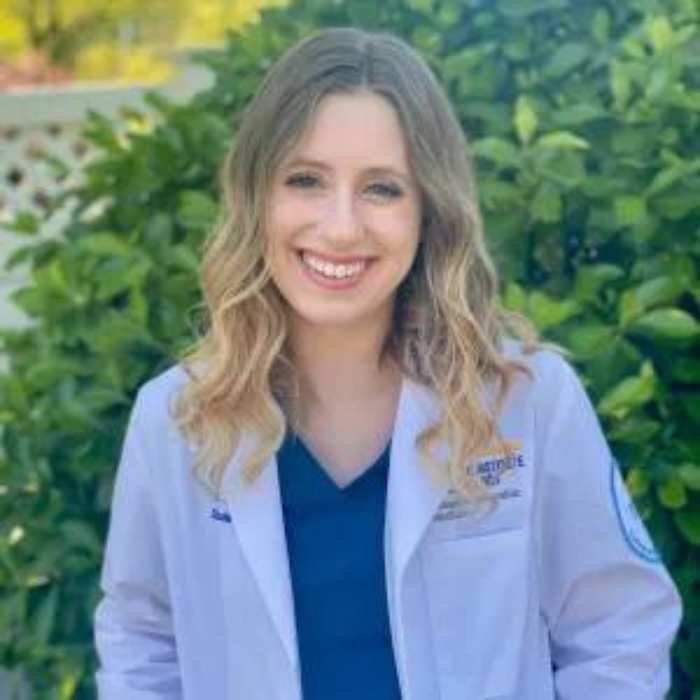
Hannah Lynch, DO
2023 Namey/Burnett Preventive Medicine Writing Award Submission
Sponsored by the ACOFP Foundation, with winners selected by the ACOFP Health & Wellness Committee, the Namey/Burnett Preventive Medicine Writing Award honors the memory of Joseph J. Namey, DO, FACOFP, and John H. Burnett, DO, FACOFP—dedicated advocates for osteopathic medicine—and recognizes the best preventive medicine blog posts submitted by osteopathic family medicine students and residents.
I chose to do my third-year medical school rotations at an under-resourced, low-income
community hospital in NYC. Going in, I knew that many of my patients would not speak English.
I would only later learn, however, exactly how critical a role language plays in the care of these
patients.
My first experience was when a mother and child came into the clinic for the first time for their
well-child visit with the pediatrician. The mom spoke Spanish, but not much English. After some
initial hesitation, she agreed to the use of an interpreter. The mother explained she was here for
her child’s two-year checkup, but that she was concerned about the child’s Down Syndrome. We
were confused since the child did not have Down Syndrome and had no medical record of this
diagnosis. We learned that when her baby was born, the doctors performed a routine test for
Down Syndrome. However, no interpreter was used and the mom had misunderstood this test
as a diagnosis. That one conversation led to two years of this mother falsely believing her child
had Down Syndrome.
Another time, I met a couple who mainly spoke Bengali, so we brought an interpreter in. We
were surprised when the interpreter also was having trouble understanding them. Digging in
deeper, we learned this couple had created their own dialect of Bengali that no interpreter could fully understand either. Neither of them had any formal education and had moved away from their home country at a young age.
Both of these stories highlight a similar theme–it is easy to feel helpless if we cannot understand
one another. These were the first moments I realized how much patient care could derail without proper communication. In some parts of the country, interpreter services are more difficult to come by. Therefore, I would like to discuss what interpreters can do, the downsides to using a translator service, and their importance in medicine.
What are interpreters?
A medical interpreter is a professional who is trained to convert spoken words in order to ensure effective communication between a healthcare provider and their patient if they do not speak the same language (1). In essence, a medical interpreter is the middle-man for communication. There are over 25 million people (and rising) in the USA that are not fluent in English (2), so it is imperative that medical professionals are able to reach these audiences and make them feel comfortable in the healthcare setting. Without interpreters, we would be unable to communicate effectively with a large subset of our country’s population.
Interpreters broker more than just language, though–they also mediate cultural gaps (2). As a cultural broker, they are a bridge between the healthcare provider and patient, helping to translate in a culturally competent way so that the patient has a full understanding of what the healthcare provider is trying to say (2). Words can have different meanings in many cultures, so having a trained professional who can translate a message (not just words) is very important to providing quality care. For instance, the word hospice might be difficult to translate literally across all languages, but the meaning can be explained by an interpreter (3). In literature, medical interpreters have been labeled as “smart technology” since they are able to give feedback to the provider and elaborate to the patient (5). Using a medical interpreter to bridge a language barrier between a patient and their healthcare provider can result in higher patient satisfaction, adherence, and reduced costs and disparities (1).
There are many types of interpreter services, including in-person interpreters, videoconference,
and phone interpreters (1). Sometimes when an interpreter service is unavailable, physicians
turn to patients’ families, friends, or other medical professionals not officially trained as
interpreters (2,8). However, this has many disadvantages since family members and healthcare
professionals often have intrinsic biases and are not trained to remain neutral in the
conversation like a medical interpreter can (8). Providers should always be encouraged to
speak the same language as the patient if possible, even if it is just to introduce themselves to
the patient in an effort to build rapport (1). The availability and type of interpreter service is
usually influenced by the financial burden it takes on the hospital or healthcare center (3).
However, there are creative solutions to this problem. For example, a small study in 2016
showed that properly trained medical students can serve as effective interpreters (7).
Challenges while using an interpreter service
Adding another person to the patient-provider relationship and interactions can understandably
provide additional barriers. Interpreters provide the invaluable service of communication
between the patient and provider, but lack of training for the providers in how to use interpreters or lack of training for the interpreter themselves can lead to miscommunications (1). Providers that use medical jargon can be a barrier for interpretation and cause confusion for the patient and their family members (3). Similarly, interpreters can be helpful as a cultural broker but sometimes interpreters can omit important information or edit what the physician is trying to say (4). One of the most important barriers, however, is limitation of time. It has been reported in past studies that using an interpreter increases the visit’s time, which can result in longer wait times for finding an interpreter (6).
There are ways to mitigate the challenges of using an interpreter service. First, hospitals can provide training for physicians on how to utilize the different types of interpreter services (1). This could include helpful tips like first finding a room with no background noise. Second, meeting with the interpreter before going into the patient’s room gives an important opportunity to update the interpreter on the patient’s pertinent history and situation (3). Third, a recent study with Hmong medical interpreters showed that matching interpreter and patient genders could also help with patient comfortability using a translator (4).
Of course, hiring interpreters is expensive, and this tends to be the main source of complaints from hospitals (3). That underscores why having affordable interpreter options would likely increase the use of interpreters in the field. Similarly, using alternative interpreter options, like training bilingual medical students or physicians, could see similar benefits (7).
Importance of interpreters in medicine
Our patient population in the United States is becoming more diverse over time, and many
people have limited English proficiency (LEP) (2). In particular, most of the LEP population
resides in California, Texas, and New York (9), although every medical provider will eventually
encounter patients that don’t speak the same language as them. The challenges of language
barriers in communication affect our entire medical system. But, medical interpreters reduce
communication errors and help patients to feel more comfortable, yielding more meaningful
dialogue with their providers (1,2). As mentioned before, it cannot be understated how important the shared cultural background between the interpreter and patient can be, as using culturally competent language can often make a huge difference in the comfort of the patient (2).
Taking a step back, as healthcare professionals, we aim to connect with our patients and guide them through mutual decision-making. This is best done when we have a good relationship with our patients. Sharing a mutual language or using a translator for effective communication is an important piece of this picture. As osteopaths, we aim to treat the whole person in a holistic and culturally competent way. To treat holistically requires shared understanding–and shared understanding requires clear and effective communication. Language and interpreters sit at the forefront of this critical mission. Their importance is paramount, and with them there is so much more we can do for our patients.
References:
1. Clarke SK, Jaffe J, Mutch R. Overcoming Communication Barriers in Refugee Health
Care. Pediatr Clin North Am. 2019;66(3):669-686. doi:10.1016/j.pcl.2019.02.012
2. Suarez NRE, Urtecho M, Jubran S, et al. The Roles of medical interpreters in intensive
care unit communication: A qualitative study. Patient Educ Couns.
2021;104(5):1100-1108. doi:10.1016/j.pec.2020.10.018
3. Silva MD, Tsai S, Sobota RM, Abel BT, Reid MC, Adelman RD. Missed Opportunities
When Communicating With Limited English-Proficient Patients During End-of-Life
Conversations: Insights From Spanish-Speaking and Chinese-Speaking Medical
Interpreters. J Pain Symptom Manage. 2020;59(3):694-701.
doi:10.1016/j.jpainsymman.2019.10.019
4. Lor M, Badenoch N, Yang MJ. Technical Meets Traditional: Language, Culture, and the
Challenges Faced by Hmong Medical Interpreters. J Transcult Nurs. 2022;33(1):96-104.
doi:10.1177/10436596211039553
5. Hsieh E, Kramer EM. Medical interpreters as tools: dangers and challenges in the
utilitarian approach to interpreters' roles and functions. Patient Educ Couns.
2012;89(1):158-162. doi:10.1016/j.pec.2012.07.001
6. Granhagen Jungner J, Tiselius E, Pergert P. Reasons for not using interpreters to secure
patient-safe communication - A national cross-sectional study in paediatric oncology.
Patient Educ Couns. 2021;104(8):1985-1992. doi:10.1016/j.pec.2021.01.017
7. Diaz JE, Ekasumara N, Menon NR, et al. Interpreter training for medical students: pilot
implementation and assessment in a student-run clinic. BMC Med Educ. 2016;16(1):256.
Published 2016 Sep 29. doi:10.1186/s12909-016-0760-8
8. Krupic F, Samuelsson K, Fatahi N, Skoldenberg O, Sayed-Noor AS. Migrant General
Practitioners' Experiences of Using Interpreters in Health-care: a Qualitative Explorative
Study. Med Arch. 2017;71(1):42-47. doi:10.5455/medarh.2017.71.42-47
9. Batalova J, Whatley M. Limited English proficient population of the United States in
2011. migrationpolicy.org. July 25th, 2013. Retrieved December 30, 2022, from
https://www.migrationpolicy.org/article/limited-english-proficient-population-united-states-
2011#:~:text=About%20half%20of%20LEP%20individuals,residents%20in%20California
%20was%20LEP.





Leave a commentOrder by
Newest on top Oldest on top